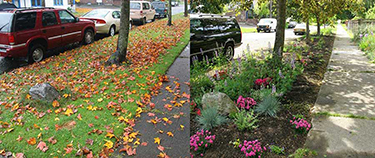|
Subscribe / Renew |
|
|
Contact Us |
|
| ► Subscribe to our Free Weekly Newsletter | |
| home | Welcome, sign in or click here to subscribe. | login |
Environment
| |
 |
February 26, 2015
Goal of Capitol Hill EcoDistrict is to make neighborhood green
Schemata Workshop

Mariano
|
The Capitol Hill EcoDistrict is a neighborhood-based sustainability initiative that serves the most densely populated urban village in the Pacific Northwest.
The EcoDistrict promotes and supports a holistic approach to growth that embraces many aspects of sustainability. The goal is to advance the health of the entire ecosystem.
The EcoDistrict is led by Capitol Hill Housing, a community development corporation and public development authority. A steering committee composed of local community members works in partnership with local organizations to help ensure the EcoDistrict’s efforts are relevant and effective.
Habitat and watershed don’t necessarily follow the street grid or our definition of Capitol Hill as a neighborhood, so we have defined an EcoDistrict study area in order to assess its progress. The goals and objectives are grouped under eight performance areas: water, habitat, culture, energy, materials, transportation, health and equity.
The EcoDistrict Index helps track the progress towards achieving targets within the EcoDistrict. The first version of the index was developed with a task force of community members and technical experts to identify key performance metrics, establish baselines and develop a reporting system to share progress. Metrics were selected to be place specific, scale appropriate, measurable, immediately relevant and easy to communicate.
The EcoDistrict Steering Committee will present our progress to the Seattle City Council’s Planning, Land Use and Sustainability Committee later this year.
In the meantime, we are making progress on a number of local community initiatives that span multiple EcoDistrict performance areas.
Neighborhood initiatives
Renewable energy is widely supported by Seattle residents, but installing a solar panel array on a home may not be feasible due to a number of challenges, including roof area, roof orientation and cost.
Capitol Hill Housing partnered with Seattle City Light to hold the first community solar project on an affordable housing project in Washington state. Participants in the community solar program can “subscribe” to receive the benefits of solar via systems built and maintained by Seattle City Light on the rooftop of a Capitol Hill Housing building.
Transportation is responsible for 40 percent of Seattle’s greenhouse gas emissions. At the district scale, parking is one of the primary criteria for transportation decisions.
We identified district-shared parking as a system in which parking can be leased across buildings. Simple in concept, a daytime office worker and a local resident who parks at night can share one space rather than taking up two.
Our approach with Pike/Pine shared parking addresses off-street residential, off-street commercial, and the relationship of those to on-street parking. We have collected an extensive amount of parking-related data, reviewed shared parking strategies being pioneered around the world, and are now using this research to make district shared parking a reality in Pike/Pine.
Natural habitat needs to be expanded, as there has been extensive loss of open space and tree canopy due to construction on formerly undeveloped sites. The Pollinator Pathway is a public design initiative founded by artist Sarah Bergmann that connects isolated landscape fragments with native plant focused, pollinator-friendly gardens in the planting strip of the public street right of way.
Grass or paving is replaced with habitat, enhancing the pedestrian experience. The first pathway connects Capitol Hill to the Central District by way of Columbia Street. The second pathway will connect the Seattle University campus to Cal Anderson Park, Lowell Elementary School, and Volunteer Park via 11th Avenue.
A cultural performance area is currently being developed for the EcoDistrict. The Capitol Hill Arts District was officially formed in late 2014 in response to recent losses of nonprofit, arts-focused organizations on Capitol Hill.
The arts are an integral and authentic experience of Capitol Hill, and are an expression of the rich diversity of the community. Residents and visitors are constantly immersed in the arts, and the EcoDistrict strives to enhance the visibility and long-term viability of arts and culture on Capitol Hill.
Building performance
Energy consumption of buildings account for the greatest percent of total energy consumption in the United States, more than either the transportation or industry sectors.
The Capitol Hill EcoDistrict has partnered with the Seattle 2030 District, a downtown-based nonprofit, to support owners and managers in improving the performance of buildings for Capitol Hill 2030.
Rising utility costs and increasingly stringent building codes are driving building owners to improve the energy performance of their properties. Water supply and treatment costs are on the rise, so building owners are taking opportunities to increase building efficiency and encourage conservation by residents.
The Capitol Hill EcoDistrict is ultimately about those that live, work and play in the neighborhood. We are currently working on definitions and metrics for the “health” and “equity” performance areas to address, among other criteria, including social cohesion, personal well-being and affordability.
We welcome community feedback, comments and support for the EcoDistrict work and look forward to sharing successes learned on Capitol Hill with other communities working to improve livability in their urban villages. More information can be found at www.capitolhillecodistrict.org
Michael Mariano is a founding partner of the architecture and urban design practice of Schemata Workshop, and co-chairs the Capitol Hill EcoDistrict Steering Committee.
Other Stories:
- Energy tools that could change the game
- Why green building has hit the wall, and what to do about it
- How to make a better business case for going green
- Making the most of your energy model
- Seattle is clamping down on waste from construction and demolition
- How to treat stormwater in urban areas — like Totem Lake
- How to convince a realist it makes sense to go green
- How do you measure the value of a green building?
- Six reasons developers should build net-zero apartments
- Federal Center South team focused on results, not ratings



